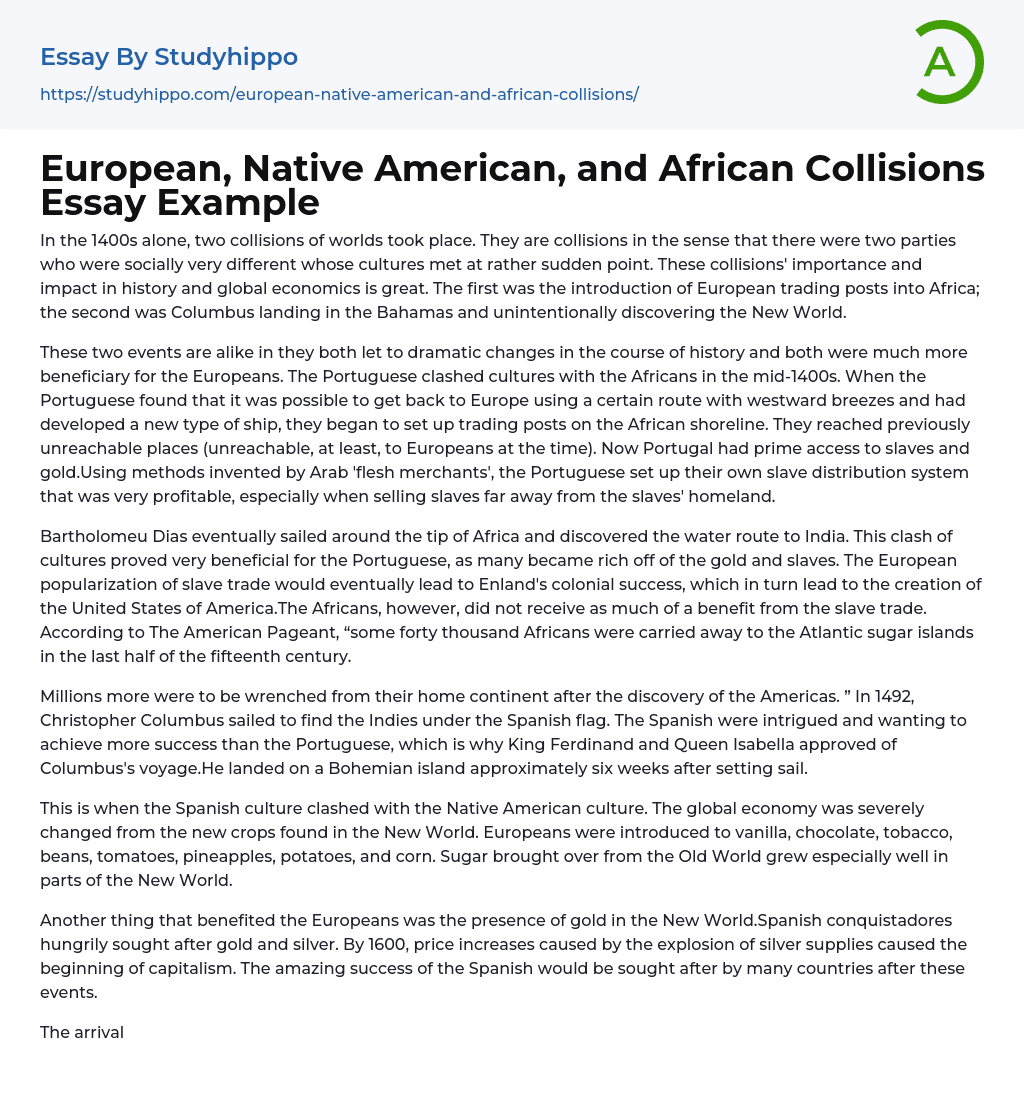Two significant encounters between diverse societies in the 15th century had a great impact on history and global economics. The first encounter involved the introduction of European trading posts into Africa, while the second was Columbus' unintentional discovery of the New World upon landing in the Bahamas.
Both events mentioned here resulted in significant changes in history and were particularly advantageous for Europeans. In the mid-1400s, the Portuguese encountered different cultures in Africa. They discovered a new western route to Europe and used their advanced ships to establish trading posts along the African coast, reaching previously inaccessible places. This enabled Portugal to gain easy access to valuable resources such as gold and slaves. Utilizing techniques developed by Arab merchants, the Portuguese created a highly lucrative slave distribution system, which was particularly profitable when selling slaves far from
...their homeland.
By navigating around the southern tip of Africa, Bartholomeu Dias created a sea route to India that proved advantageous for the Portuguese. This led to cultural interaction and helped them accumulate wealth from gold exploitation and enslavement. These factors facilitated British colonialism and eventually contributed to the formation of the United States. However, African communities did not benefit from the slave trade as about 40,000 people were transported to Atlantic sugar plantations in the latter half of the 15th century, according to The American Pageant.
Following the uncovering of the Americas, a vast number of individuals were compelled to leave their homeland. Christopher Columbus embarked on a voyage in 1492 with the aim of discovering the Indies while representing Spain. With aspirations of surpassing Portugal, King Ferdinand and Queen Isabella granted Columbus permission. After six weeks at sea, h
eventually arrived on an island in Bohemia.
During the emergence of new crops in the New World, there was a clash between Spanish and Native American cultures. The introduction of various crops such as vanilla, chocolate, tobacco, beans, tomatoes, pineapples, potatoes, and corn brought significant changes to the global economy for Europeans. Additionally, some parts of the New World saw great growth in sugar from the Old World.
The Spanish conquistadores were eager to obtain the gold and silver found in the New World, leading to a surge in silver resources. This advantage sparked price hikes that eventually gave rise to capitalism by 1600. The success of the Spanish following these events was highly desired by numerous nations.
When Europeans arrived in Native American territories, the population of indigenous people suffered a serious decrease. Despite the fact that these outsiders brought new culinary options and introduced livestock such as horses, cows, and pigs, they also spread many diseases like smallpox, measles, bubonic plague, influenza, typhus, diphtheria and scarlet fever which had disastrous effects on the Indian society. Regrettably, due to these sicknesses more than 90% of Native Americans died.
In 1540, Tenochitlan, the capital of the Aztec empire, was invaded by Hernan Cortes and other Spanish conquistadores. Prior to this invasion, the Spaniards had already defeated Indian armies in pursuit of silver in 1532. Although initially welcomed by chieftain Montezuma, they took advantage of the locals for their own financial gain. This led to resistance from the Aztecs who were unable to withstand both factors - a combination of Spanish guns and a smallpox outbreak which quickly overtook the city. Despite being just as large as most
European cities at that time, Tenochitlan fell due to its inability to resist against these two factors which favored the Europeans.
The Europeans gained more power during both of these historical periods, which put the Africans and Indians at risk. Despite being destructive at times, these clashes of cultures were also constructive as they brought about events and ideas that are essential to our world today.
- Slave Trade essays
- Christopher Columbus essays
- Exploration essays
- Pilgrims essays
- Simon Bolivar essays
- John Locke essays
- 9/11 essays
- A Good Teacher essays
- A Healthy Diet essays
- A Modest Proposal essays
- A&P essays
- Academic Achievement essays
- Achievement essays
- Achieving goals essays
- Admission essays
- Advantages And Disadvantages Of Internet essays
- Alcoholic drinks essays
- Ammonia essays
- Analytical essays
- Ancient Olympic Games essays
- APA essays
- Arabian Peninsula essays
- Argument essays
- Argumentative essays
- Art essays
- Atlantic Ocean essays
- Auto-ethnography essays
- Autobiography essays
- Ballad essays
- Batman essays
- Binge Eating essays
- Black Power Movement essays
- Blogger essays
- Body Mass Index essays
- Book I Want a Wife essays
- Boycott essays
- Breastfeeding essays
- Bulimia Nervosa essays
- Business essays
- Business Process essays
- Canterbury essays
- Carbonate essays
- Catalina de Erauso essays
- Cause and Effect essays
- Cesar Chavez essays
- Character Analysis essays
- Chemical Compound essays
- Chemical Element essays
- Chemical Substance essays
- Cherokee essays




